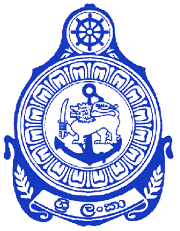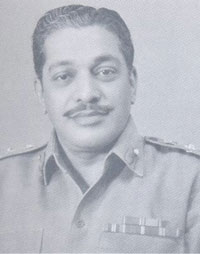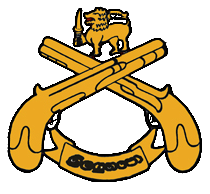
The Sri Lanka Navy (SLN) is the naval arm of the Sri Lanka Armed Forces and is classed as the country's most vital defence force due to its island geography and is responsible for the maritime defense of the Sri Lankan nation and its interests. The role of the Sri Lanka Navy is to conduct operations at sea for the defence of the nation and its interests and conduct prompt and sustainable combat operations at sea in accordance with the national policies.

The Sri Lankan Army (SLA) is the oldest and largest of the Sri Lanka Armed Forces. Established as the Ceylon Army in 1949, it was renamed when Sri Lanka became a republic in 1972. In 2010, the Army had approximately 200,000 regular personnel, between 20,000 and 40,000 reserve (volunteer) personnel and 18,000 National Guardsmen and comprises 13 operational divisions, one air-mobile brigade, one commando brigade, one special forces brigade, one independent armored brigade, three mechanized infantry brigades and over 40 infantry brigades. From the 1980s to 2009 the army was engaged in the Sri Lankan Civil War.

The Sri Lankan Armed Forces award medals and their associated ribbon bars in recognition of various levels of service, personal accomplishments and commemorative events while a regular- or volunteer serviceperson is a member of the Sri Lanka Army, Sri Lanka Navy and the Sri Lanka Air Force. Together with military badges, such awards are a means to outwardly display the highlights of a serviceperson's career.

The Parama Weera Vibhushanaya is the highest decoration awarded by the Sri Lankan military, equivalent to the British Victoria Cross and the United States Medal of Honor. The medal is awarded to all ranks of the tri services, to both regular- and volunteer forces, in recognition of:
...individual acts of gallantry and conspicuous bravery of a non-military nature of the most exceptional order performed voluntarily with no regard to his own life and security with the objective of saving or safeguarding the life or lives of a person or personnel imperiled by death or for a meritorious act or a series of acts of a humane nature of an exceptional order displayed in saving life from drowning, fire and rescue operations in mines, floods and similar calamities under circumstances of grave bodily injury or great danger to the life of the rescuer...

The Sri Lanka Volunteer Naval Force (SLVNF) is the volunteer and volunteer reserve force of the Sri Lanka Navy, established in 1937 as the Ceylon Naval Volunteer Force. It is headquartered at SLNS Lanka, Welisara, and is tasked with a support and complementary role to the country's navy, partly by serving as a pool of civilian talent and expertise otherwise lacking in the regular naval force, and partly by acting as a reserve force during times of war.

Between 1948 and 1972, Ceylon was an independent country in the Commonwealth of Nations that shared a monarch with Australia, Canada, New Zealand, the United Kingdom, and certain other sovereign states. In 1948, the British Colony of Ceylon was granted independence as Ceylon. In 1972, the country became a republic within the Commonwealth, and its name was changed to Sri Lanka.

General Deshamanya Don Sepala Attygalle, LVO was a Sri Lankan military leader, civil servant and diplomat. The longest serving Commander of the Sri Lankan Army (1967–1977), he went on to serve as the Permanent secretary to the Ministry of Defence and Sri Lankan High Commissioner to the United Kingdom.

The Sri Lanka Corps of Military Police (SLCMP) is the branch of the Sri Lanka Army responsible for the policing of service personnel and providing a military police presence on service property, operations and exercises. It is made up of three regular regiments and with headquartered at Regiment Center Polhengoda, Colombo. Like other military police around the world, they continue to wear white webbing with barrack dress but white gaiters.

The Sri Lanka Armed Services Long Service Medal is a service award presented to all ranks of the tri-forces of Sri Lanka. Service personnel are eligible for the award on the completion of 12 years' continuous service with perfect character and discipline. General officers commanding/area commanders/commanding officers forward recommendations to service commanders. Reserve- or volunteer forces may qualify for this award provided that their service periods add up to 12 years.

The Republic of Sri Lanka Armed Services Medal was awarded to members of the regular and volunteer forces of the Military of Sri Lanka who were in service on 22 May 1972, subject to recommendation by the commanders of the respective service commanders. Members of the then Ceylon Cadet Corps were ineligible. The award commemorated service at the time the country adopted a republican constitution, ceasing to be a Commonwealth realm.

The following tables present the military ranks and insignia of the Sri Lanka Army. The ranks are similar to the British army officer ranks and the other ranks.
The Ceylon Armed Services Long Service Medal was a service medal of Ceylon from 1968 to 1972. It was granted to all ranks of the regular forces of the Ceylon Army, Royal Ceylon Navy and Royal Ceylon Air Force provided they had completed 12 years of service. It was replaced by the Sri Lanka Armed Services Long Service Medal in 1972 when Sri Lanka became a republic.
General Tissa Indraka Weeratunga, VSV was a Sri Lankan military leader. He was a former Commander of the Sri Lankan Army and first General Officer Commanding (GOC) of the Joint Operations Headquarters (JOH), he was later Sri Lanka's High Commissioner to Canada.

The Army Headquarters is the headquarters of the Sri Lanka Army and is located in the Defence Headquarters Complex in Sri Jayawardenapura Kotte. It was established on 1 October 1949 in the Echelon Barracks which was the headquarters of the British Army in Ceylon. It later moved to the Rifle Barracks and then to the Old Army Headquarters Complex, before moving to the new Defence Headquarters Complex.
Admiral Deshamanya D. Basil Gunasekara was the Commander of the Sri Lanka Navy from 1973 to 1979.

The Sri Lanka Armed Forces is the overall unified military of the Democratic Socialist Republic of Sri Lanka encompassing the Sri Lanka Army, the Sri Lanka Navy, and the Sri Lanka Air Force; they are governed by the Ministry of Defence (MoD). The three services have around 346,700 active personnel; conscription has never been imposed in Sri Lanka. The Sri Lanka Coast Guard is also under the purview of the Ministry of Defence but is staffed by civilian personnel.

Brigadier (Brig) is a senior rank in the Sri Lanka Army. Brigadier is a superior rank to Colonel, but inferior to Major-General. The rank has a NATO rank code of OF-6, equivalent to Commodore in the Sri Lanka Navy and Air Commodore in the Sri Lanka Air Force.
Rear Admiral D. V. Hunter (1917–19??) was Sri Lankan naval officer, who served as the 7th Commander of the Sri Lankan Navy.

Sri Lankan military bands refer to the joint-service musical units of the Sri Lanka Armed Forces representing the Sri Lanka Army, the Sri Lanka Navy, and the Sri Lanka Air Force. The three bands mentioned, which were established in 1949, 1952 and 1970 respectively and are the seniormost in the armed forces. They are composed of many ceremonial marching bands as well as concert bands which are base for the band's success. The band participates in main social and cultural events, including formal state visits and military parades. All army regiments also contain a regimental band for ceremonial duties.
Brigadier Percy Douglas "Douggie" Ramayanayake was a senior Sri Lanka Army officer who was the founder of the Sri Lanka Engineers. He had served as the Commander, Task Force Anti Illicit Immigration.













